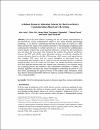A robust resource allocation scheme for device-to-device communications based on Q-Learning

View/
Date
2020Author
Amin, AzkaLiu, Xihua
Khan, Imran
Uthansakul, Peerapong
Forsat, Masoud
Mirjavadi, Seyed Sajad
...show more authors ...show less authors
Metadata
Show full item recordAbstract
One of the most effective technology for the 5G mobile communications is Device-to-device (D2D) communication which is also called terminal pass-through technology. It can directly communicate between devices under the control of a base station and does not require a base station to forward it. The advantages of applying D2D communication technology to cellular networks are: It can increase the communication system capacity, improve the system spectrum efficiency, increase the data transmission rate, and reduce the base station load. Aiming at the problem of co-channel interference between the D2D and cellular users, this paper proposes an efficient algorithm for resource allocation based on the idea of Q-learning, which creates multi-agent learners from multiple D2D users, and the system throughput is determined from the corresponding state-learning of the Q value list and the maximum Q action is obtained through dynamic power for control for D2D users. The mutual interference between the D2D users and base stations and exact channel state information is not required during the Q-learning process and symmetric data transmission mechanism is adopted. The proposed algorithm maximizes the system throughput by controlling the power of D2D users while guaranteeing the quality-of-service of the cellular users. Simulation results show that the proposed algorithm effectively improves system performance as compared with existing algorithms.
Collections
- Mechanical & Industrial Engineering [1499 items ]

